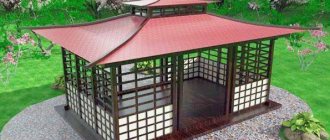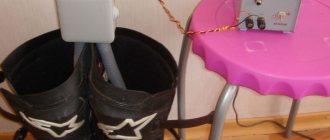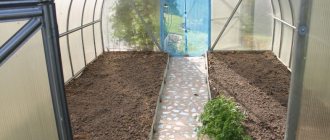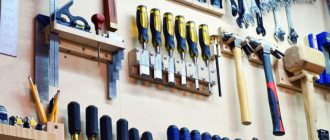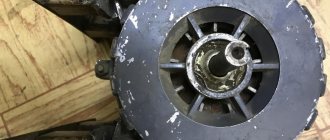If you are the owner of a plot of land, then at least once you have been faced with the need to dig holes for supports and pillars when decorating the appearance of the territory. Sometimes it happens that a hole is needed in a not very convenient place. It is quite difficult to cope with this task with a simple shovel. You can, of course, borrow a hand drill from a friend or call a specialist who can handle the appropriate tool. But if you plan to carry out such work from time to time, then you can make a garden drill for poles with your own hands from scrap materials.
The tool will be easy to use and compact, which is very convenient for storage. Typically, hard metal is used for such work. With its help, you can split plant rhizomes and small stones into pieces. Such a device will allow you to dig a hole by rotating the equipment around an axis like a corkscrew.
Selection of cutting part
The main purpose of the drill is to dig holes. Wells are made with a cutting part, which can have different shapes, namely:
- half-disc shape;
- type of auger;
- two-blade;
- helical;
- removable;
- multi-tiered;
- whole.
If you want to make a pole drill with your own hands, you must determine the design features of the device. Some models have small blades at the bottom, while at the top they increase to larger sizes. By purchasing a factory drill, you will receive an effective and functional tool for use. But it is not always possible to insert it into the soil to the required depth; in addition, the nozzles of such devices may not have the correct diameter.
Knives and mounting methods
The working parts are made in different shapes: rounded, rectangular and for spiral screws (augers). Also, homemade hand drills come with removable and non-removable blades. In the first case, steel shelves are attached to the lower end of the rod using electric welding at an angle of 25-30 degrees, and then several holes are made for fasteners (a similar operation is performed with the blades).
The elements are connected using bolts or studs and nuts with washers. “Stationary” discs are simply welded to a metal rod. To ensure a tighter fit of the finished blades to the pipe, you will first need to cut semicircular holes along the edges before installing them.
Recommendations for the manufacture of individual parts
Before you start making a pole drill with your own hands, you must understand the components of this tool, among them the following should be highlighted:
- baking powder;
- soil receiver;
- shaper plow;
- screw.
The baking powder consists of two planes or a screw. The latter is similar to a spiral; in this unit the knife is located on a rod. There is also a soil receiver in the drill. Soil is collected here, which makes it easier to drill holes with a diameter of up to 35 cm. When making a drill for posts with your own hands, you will need to equip it with a shaper, which will be located in the lower part. This unit allows you to strengthen the columnar foundation, which is required when constructing large buildings.
A simple means of small-scale mechanization for the garden
It is easiest to make such a tool yourself. Its design includes:
- cutting part made of steel sheet;
- drill tip;
- a rod made of round or square pipe;
- handle.
The cutting blades of the drill are made of two steel semicircles with a thickness of 4 mm and pointed edges. Their diameter is calculated according to the size of the required wells. In the center of the semicircles, a recess is cut out in the shape of the rod for a better fit. Blades are usually welded to a rod with a diameter of ¾ inch or 20×20 mm, but it is more convenient to make several replacement pairs and bolt them to the rod. To do this, you need to weld fastening shelves made of strong steel at the desired angle and make holes in them.
A 0.5 meter long handle is attached perpendicular to the rod, the length of which is made up of the depth of the hole and an additional 60 cm. A drilling tip is attached to the other side. It is needed for stability and initial loosening of the earth. If the garden auger turns out to be too long, you can make a collapsible, folding or telescopic rod.
Blade knives can be made from two round halves or from an open circle with offset edges. In any case, the edges of the blades should be separated by 30°. This is necessary for successful work on dense soils. Angles or stops made of thick steel will enhance performance.
Preparation of materials
If you decide to make a drill for poles with your own hands, then at the first stage you need to start preparing everything you need. Among the details it is worth highlighting:
- nut;
- drill;
- vice;
- pieces of metal pipe.
You will also need an M 20 bolt. You need to take 2 disks with a diameter of 100 to 150 mm. As for the drill, it must have a tip with a diameter of 20 mm. A metal pipe will lie at the base. You will need two sections of 500 mm and one of 400 mm. It is better to take a pipe with a wall thickness of 3.5 mm and an outer diameter of 40 mm. With these parameters, the finished product will be durable and will be able to withstand hard ground.
Assembling a vibrator with your own hands from a drill
If you need an internal vibrator, you can simply assemble it from an electric drill.
Before making a homemade vibrator for concrete, you need to understand what the operating principle of the device is based on.
An ordinary drill can be found in almost every home. The main driving force of such a device will be the transformation of rotational motion into oscillatory motion.
The main driving force of the device will be the most ordinary drill
Selecting material for vibrator assembly
To assemble such a device from a drill, any tool with a power of 1 kW or more is suitable. You will need an eccentric nozzle and a durable stainless steel tip. In addition, the following must be available:
- stainless steel tube 55 cm long and Ø 4 cm;
- metal rod Ø 15 mm;
- a piece of rectangular metal rod;
- two high-quality bearings and a bushing;
- bendable reinforced hose with waterproofing or durable rubber tube;
- internal rod for the tube (you can take the speedometer cable).
The mass of the eccentric creates a force that causes the attachment to oscillate at a certain frequency
Assembly tools
To assemble a vibrator you need to have a set of the following tools:
- set of metal drills;
- electric or gas welding;
- hacksaw;
- rectangular rod.
Preparing tools
You can borrow the discs from a regular circular saw or make them yourself. To do this, you should find 3mm sheets of metal. Among the tools that will be needed in the work are:
- angle grinder;
- welding machine;
- metal drills;
- hammer;
- drill.
If you do not have a tip with a drill, you can replace it with a drill with a shank that looks like a cone. Its diameter must match the screw. In order to prevent injury, you should use soft bicycle handles.
Should you make the design yourself or contact a company?
Of course, the use of homemade inventions has positive aspects. For example, you can save a lot of money by making your own source. There are also many simple drawings and diagrams on how to make a drilling tool. However, all this has an obvious disadvantage - it is impossible to dig the source to great depth.
Read also: Calculate beam deflection online
Therefore, if the water in the area is deep, it is better to contact a specialized company. Perhaps it will use hydraulic installations. In this case, you will need to think through everything down to the smallest detail:
- Find the exact place with water.
- Immediately determine the place for testing.
- Discuss the cost of the work.
- Set work deadlines, etc.
In any of the options, our material should help you in this difficult task.
Step-by-step work
If you decide to make a manual post drill with your own hands, draw a circle with a center on a metal sheet. This part will be the blade. The circle is cut out with a grinder, after which a cutting line should be drawn along the diameter line. At the next stage, you need to draw a cutout line that will correspond to the circumference of the collar. The disk is divided into two parts, after which a hole for the knob should be cut. At the end of the pipe, which will serve as a wrench, four longitudinal lines must be made with an angle grinder. These are formed into a point using a hammer. In this case, you need to make cuts at the very center of the pipe.
The tip is processed by welding. The driver should not become clogged with soil during operation. When making a drill for fence posts with your own hands, in the next step you will need to connect the disk to the collar using a weld. This is done at a distance of 5 cm between them. It is necessary to maintain the angle of the plane of rotation, which is 20˚.
Pros and cons of a homemade drill compared to a factory drill
Homemade pit drilling gives the owner the following advantages:
- cheapness. In fact, you only need to purchase a circular saw blade (or you can get by with a used blade) and use a tool that is in the arsenal of almost any male craftsman;
- Possibility of quick self-repair. If the disk is bent or blunt, it can be straightened, sharpened, or simply replaced by cutting off the old one and welding on a new one. The same is true with drives, which are a separate and removable structural element.
In general, the product is excellent for producing small recesses, but it also has some disadvantages:
- low productivity. Attaching drives in the form of an angle grinder or a hammer drill does not allow you to effectively drill through frozen soil and lift large volumes of soil. Chainsaws are much more powerful, but one circumstance should be taken into account - the longer the rod, the weaker the drive will be able to overcome resistance in the ground.
- Factory automatic models are more convenient. Additional handles are mounted on them. They can also be mounted on a homemade product, but the design of a hammer drill or grinder does not always allow this.
We have examined in detail the issue of self-manufacturing a hole drill with manual and automatic drive. It should be noted that self-production always allows you to save money, and following our recommendations makes it possible to produce a high-quality and reliable product.
Working on an extension pipe
Next, you can begin working with the extension pipe. It must be equipped with a handle. This part is welded in the shape of the letter T. An amplifier in the form of a scarf is attached to it. The workpiece should be inserted into the driver, making a hole between these parts. This will allow you to fasten the parts with a pin. There should be several holes so that the length of the product can be adjusted. You can complete the work process by sharpening the blades. The edge of the cutter is processed so that when rotating the tip is directed downward.
Flowerbed with perennials - varieties
Part of the originality of landscape design is the ability to combine flowers in one place. Therefore, a flower bed of continuous flowering can be different:
- Modular flower garden - between the plants there is a line in the form of tiles and other architectural products;
- Mixborder is a contrasting composition, located mainly along paths and under windows;
- Tapeworm is a collection of plants that are friends with each other due to one specific characteristic - palette, foliage shape or height;
- Rabatka is an oblong planting of flowers that together form an ornament or a specific pattern;
- Border - a small strip with low-growing plants;
- Rockery - a flowerbed with flowers, complemented by stones;
- Rock garden - a high stone flower bed with flowers.
We invite you to familiarize yourself with the Tomato jam recipe with photos of how to prepare it on
As for the size of the flower bed, each gardener has his own requirements for this parameter.
The house is of particular importance. When the structure is located in the center of the yard, it is recommended to arrange flower beds in front of the windows, since there is plenty of background for flowers. In other cases, it is better to decorate paths, fences, and ponds with variegated plants.
A lot depends on the shape of the flower bed. Smooth lines suit a well-groomed lawn, while a round flowerbed in a country house requires emphasis through low fences.
Application of protective coating
Having made a drill from a pipe for poles with your own hands, you must protect it from external influences and premature aging of the material. This will prevent rust from occurring. The parts of a homemade drill are processed with sandpaper and coated with a primer. A phosphating solution is applied on top. The finished product after this treatment can be painted.
When using a tool, after each use it is usually disassembled and cleaned of dirt and dust. Particular attention should be paid to connections. They are coated with a special lubricant that helps repel water. You should not miss this moment, because proper care will be an excellent prevention of bolt jamming and will allow the equipment to operate uninterruptedly for a long time.
Drilling Key Points
When considering the process of drilling wells, you will come across several technologies at the same time, each of which has its own characteristics:
- impact technology;
- perforated;
- screw;
- hydraulic.
When using impact technology, you will need to acquire a driving ramp and bailer.
A ramp is a sharp and durable object designed to destroy ground rocks. It must have a special valve installed in the tip. After each blow, a little broken rock or soil remains in it. Periodically, the device must be removed from the drilled well in order to remove the accumulated soil in the valve.
A bailer is an equally durable item. It is they who will strike the slope.
This method is considered quite time-consuming and labor-intensive, which is why it is used only in some cases. Only on soft ground.
The use of perforation technology occurs only when creating certain types of wells. In this case, perforation technology is used in conjunction with percussion. Let's look at this process in more detail.
- Initially, you need to dig a deep pit manually
- Create a long pipeline by connecting metal pipes.
- Seal the joints.
- At the bottom of the resulting pipeline it is necessary to make a filter from a metal mesh.
- The resulting pipeline must be driven into the pit until it reaches the water.
- Use a pump to get rid of sand that got into the pipeline during the process.
As a result, you should have a ten-meter well.
Although the technology is known for its simplicity, sources created using it can be used for three decades. Speaking about the choice of soil for drilling, it is worth noting sand.
If we choose the most popular of all technologies, then it is undoubtedly the auger. Thanks to a wide selection of drills, you can make a well in almost any area without worrying about the hardness of the soil. This is possible thanks to the use of a special blade bit.
The drilling process is somewhat reminiscent of turning a screw. In addition, you do not need to remove the drill from the ground every few centimeters to remove accumulated soil. The augers take care of this by throwing it out.
Using auger technology, you can drill wells with a large diameter (up to 80 cm). The only disadvantage is the impossibility of using this technology in areas with loose soil. This is due to the fact that during the drilling process the walls of the well constantly collapse.
Hydraulic technology is special in that strong water pressure is involved in the drilling process. Hence the name. But in fact, not just water is used, but a special acid solution.
The use of this technology makes it possible to drill insufficiently large wells in comparison with previous technologies. We are talking about a 15-meter depth and a 30-centimeter diameter.
How to improve the tool
When making your own garden post auger, you can think about improving it. When drilling holes, you may encounter large rhizomes that lie tightly in the ground. Sharp edges make work easier. For ease of use, teeth should be cut on the sloping area of the blade or the cutting part should be rounded.
The design can be improved by adding removable cutters. They will allow you to drill holes of any diameter. In addition to the manufacture of spare parts, it is necessary to provide for their attachment to the collar. They are connected by two iron plates, fixed by welding. Two holes are drilled into the mounting plates and blades for the bolts. The cutters are fixed with M 6 bolts. The bolts may interfere during operation. To eliminate this problem, they are screwed in with the threads facing up.
If you want to make the best DIY post drill, you can improve it using one more method. To do this, a narrow metal plate is cut out and turned into a cone using a grinder. This will improve the efficiency of the lower end of the knob. The dimensions of the plate are 10 x 2 cm. As a result, you should get a kind of point. There is no need to make cuts in the collar. Metal plates are inserted into the end and secured by welding. They are flattened to form a peak.
If you want to use a pike, you can base it on a different method of making it. To do this, take a 17-centimeter metal plate, from which a screw similar to a corkscrew is cut out. The further algorithm of actions will be the same as in the first option.
If you decide to make a pole drill with your own hands, photos of such structures will allow you to understand which design to give preference to. If a screw is provided, a drill can play its role. It should be able to handle wood and metal. Such a tool will penetrate the soil more easily and will drill holes of the required depth.
If you are working with dense deep layers of soil, you can weld a small flat cutter between the cutter and the pick. This design will allow you to loosen the ground and center it when drilling. For such a part, you need two metal plates 3 x 8 cm. A trick of this kind will speed up the work with the tool.
When making a drill for installing pillars with your own hands, you can supplement it with cutters made from disks that are designed for working with stone. The circles are cut along the radius, and the hole widens in the center. It must match the diameter of the knob. Bending the disk allows you to get something like a screw or a corkscrew. This part will only need to be welded using the algorithm described above.
The cutter can be made from a circular saw blade. The teeth will cope with rhizomes and hard soil. You can upgrade the tool at your discretion. But no matter how high-quality it is, before the drilling process it is better to loosen the soil with a shovel, then the device will penetrate the soil well and the work will go faster.
Auger drill
Due to the large number of turns, an auger auger creates significant resistance, that is, it is much more difficult to work with it than with a garden auger. But augers are used mainly in the presence of a mechanized drive - when making a drill for deep wells - for water, for installing underground probes for a heat pump, etc.
This is what an auger drill looks like
To make a homemade auger drill, you will need several metal disks. The number of disks is equal to the number of turns. The disks are cut identically, a hole is cut in them in the center for the rod, as well as an identical sector - so that they can be welded.
A sector is marked in the rings and cut out
The discs are welded on one side, then, slightly stretching the resulting accordion, the seam is welded on the other side. Rings are welded on the outer disks. The welded discs are placed on the rod, the lower edge is welded.
It turns out to be such a big spring
Next you will need a winch. The blank for the auger is secured, the winch hook clings to the ring and is stretched to the required length, after which the auger is boiled.
Almost done
Distinctive features of the method
The method involves extracting waste rock with water pumped under pressure into the mine cavity. Drilling tools are not used to remove destroyed layers.
The technology consists of a combination of 2 processes:
- the formation of a vertical well in the ground through the alternate destruction of soil layers;
- extraction of crushed soil fragments from a wellbore under the influence of working fluid.
The process of mixing mud for drilling.
The creation of the necessary force required to immerse the cutting tool into the rock is facilitated by the own weight of the equipment, consisting of a string of drilling rods and equipment for pumping fluid into the well.
To make a washing solution, mix a small amount of clay suspension in water in a separate pit and stir it with a construction mixer until it reaches the consistency of kefir. After this, the drilling fluid is directed into the wellbore by a motor pump under pressure.
During hydraulic drilling, the liquid medium performs the following functions:
- removal of fragments of destroyed rock from the body of the water shaft;
- cutting tool cooling;
- grinding the internal cavity of the pit;
- strengthening the mine walls, which reduces the likelihood of the mine collapsing and the well shaft being buried by the dump.
From pipe sections 1.5 m long, connected by threaded fasteners, a column is formed, which lengthens due to the growth of fragments as the well deepens.
Hydrodrilling technology is optimal for rocks with a high concentration of sand and clay. It is not advisable to use this technique for arranging an autonomous source on rocky and swampy soils: massive and viscous layers of soil are difficult to wash out with water.
Caring for the bracelet
First you need to understand the main rule - use the tool exclusively for its intended purpose. You can make a hole only when you are sure that the drill is intended for a certain type of soil. If he is unable to work on such ground, he will most likely break on the first try.
You need to carefully read the instructions and technical specifications and not demand more from the tool than it is capable of performing. It is also necessary to study the technical features of the work. For example, with a hand-held hole drill you can make no more than 35 holes per day.
When working, the additionally installed tripod system greatly helps. It fixes the drill and makes it easier to pull it off the ground. And a special lever will help you get it out. It is clamped, and the drill is turned counterclockwise and removed. For long-lasting operation, it is recommended to lubricate the drill with anti-corrosion substances, and also paint it to secure the result.
Features of devices
Before making a decision to purchase or make it yourself, understand the main features and understand what to use it for. This is a universal tool; its use will help facilitate many types of work on a summer cottage or garden plot:
- Quickly and efficiently make holes for planting shrubs and trees. If there are a lot of holes, then digging with a shovel will take a long time, but if you take a special tool, you can prepare the holes quickly. At the same time, they will be of ideal shape, the same size and depth.
- Dig holes for a columnar foundation for a house or other building. Most often, they buy options with replaceable blades that can be quickly removed to install the ones suitable for the job.
- Make holes for fence posts. When installing a fence, most of the time is spent on excavation work. With a drill, the process will take much less time; the main thing is to tension the cord in advance and accurately mark the locations of the pillars. And determine the depth in order to make a mark on the handle along which to make identical indentations.
- Make a well for water. In this case, in addition to the tool itself, you will have to prepare extension cords; with their help, you can go 30-40 meters deeper and arrange a water source on your own.
- The diameter of the pit can be from 50 to 400 mm. The depth depends on the length of the rod; in standard models it is approximately a meter, in extendable models it is much more.
Advice
! For subsidiary farming, the simplest manual option is enough. If the volume of work is large, it is better to buy a motorized model.
The use of devices is allowed only on loose soils without stone or other dense layers. If the drilling part hits something hard, then you should either move to another place or break through the obstacle with a special tool.
Adjustment rod
In order for a homemade circular grinder to allow you to adjust the depth of the cut, it is necessary to provide a special rod in the design. A structural element is made from a steel rod with a diameter of about 4-6 mm. One end of the workpiece is bent in the shape of a loop, spilled out and fixed with the front bolts of the corner stop.
A thread is created on the tail of the rod, which will subsequently fit into a special adjustment hole on the handle of the tool. Before installing the rod, one nut is placed on its thread. After the tail part of the element is threaded into the hole on the handle, the second nut is screwed on. Thanks to the tightening and loosening of these fasteners on the thread, the depth of cut is actually adjusted during the operation of the homemade circular saw.
Shock-rope technique
You can drill a hole in the ground for a well or install a pole not only with a rotary type tool. To perform similar work, the shock-rope technique is also used. You can carry out drilling work in this way yourself, and the depth may be suitable for the well. A drilling rig can be purchased or made from scrap materials. It consists of the following parts:
- tripod 2.5-3 m high;
- projectile (bailer);
- cable;
- winch.
The operating principle of this technique involves dropping a tubular projectile onto the well site. Due to its own mass, the bailer enters the soil and grabs it. At the lower end of the working part of the installation there is a valve that holds the soil extracted from the well. After removing the projectile, it is deployed with the technical hole down and the accumulated soil is shaken out with blows from a heavy tool - a hammer or crowbar.
Manufacturing of the installation
To prepare the drilling rig for the percussion-rope technique, you need to place a high tripod at the drilling site. It is made of high strength metal, but it is recommended to make spacers. A cable block is attached to the top point of the tripod; it must be designed for the maximum weight of the projectile filled with wet soil, taking into account a reserve of about 50 kg.
To remove the bailer from the hole in the soil, you need to use a winch with a cable. They are also selected based on mass. It is fashionable to use a manual or automatic winch for drilling, but the fasteners must match. To fix the lifting device, an object that exceeds the mass and loaded with soil, a projectile or a static object, for example a tree, is suitable.
Structure of the bailer
A bailer is a tubular projectile for percussion-rope drilling. The main part contains soil mined during well drilling. To capture, a petal or ball-type valve is made at the bottom of the projectile. The distance from the cutting part is at least 5-7 cm. The diameter of the blank for the bailer must correspond to the expected size of the well.
For reference!
The depth of the well with the percussion-rope drilling method increases by 40-50 cm in one approach. But, you should not focus on this parameter when making a bailer yourself.
The drilling speed depends on the mass of the working part of the tool. To increase this parameter, it is recommended to place a weight at the top of the projectile. For this purpose, use pancakes with holes in the middle or fill the top of the bailer with lead. When pouring along the length of the workpiece, it is necessary to take into account the place with the partition. The algorithm for making a bailer is as follows:
- The cable fastening must be located in the upper part of the pipe along the center line. To do this, weld a transverse strip and drill a hole in it according to the diameter of the cord used.
- The lower end of the pipe needs to be sharpened. Depending on the softness of the soil, you can choose a ring type (for hard soils) or a serrated type (for loose and soft soils). If there is a muffle furnace, the edge is hardened.
- To clean the internal cavity of the projectile, a longitudinal hole 3-4 cm wide is cut in the upper third. During percussion-rope drilling, the soil becomes densely packed into the projectile - it can be loosened with a crowbar and shaken out.
When working with a bailer, you need to pay attention to the condition of the cutting edge - when that part spills, you need to use other drilling methods. This is due to the fact that large stones are easier to remove from the hole with an auger tool
In dense and viscous soil, it is better to attach a bell-shaped collar to the end of the bailer, with the extension downwards.
